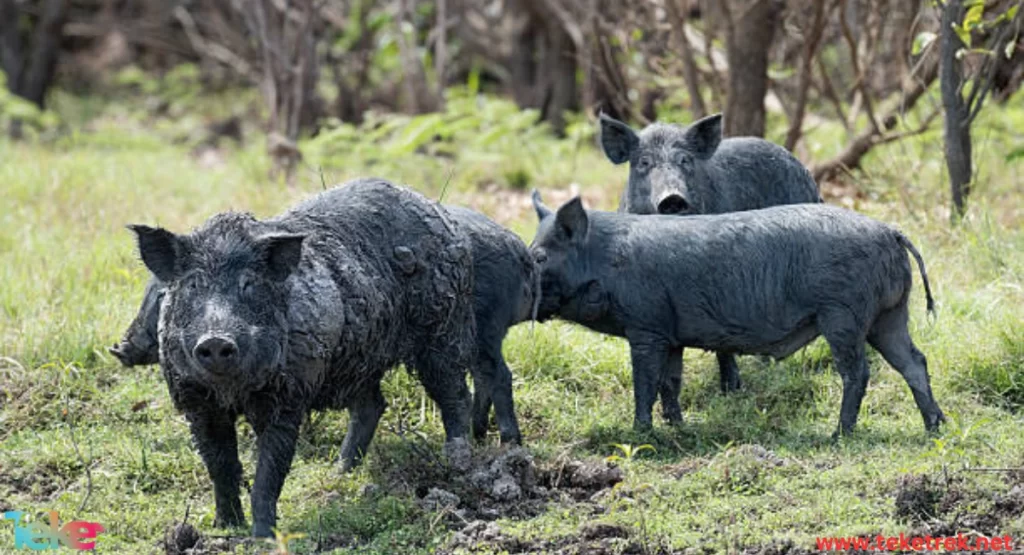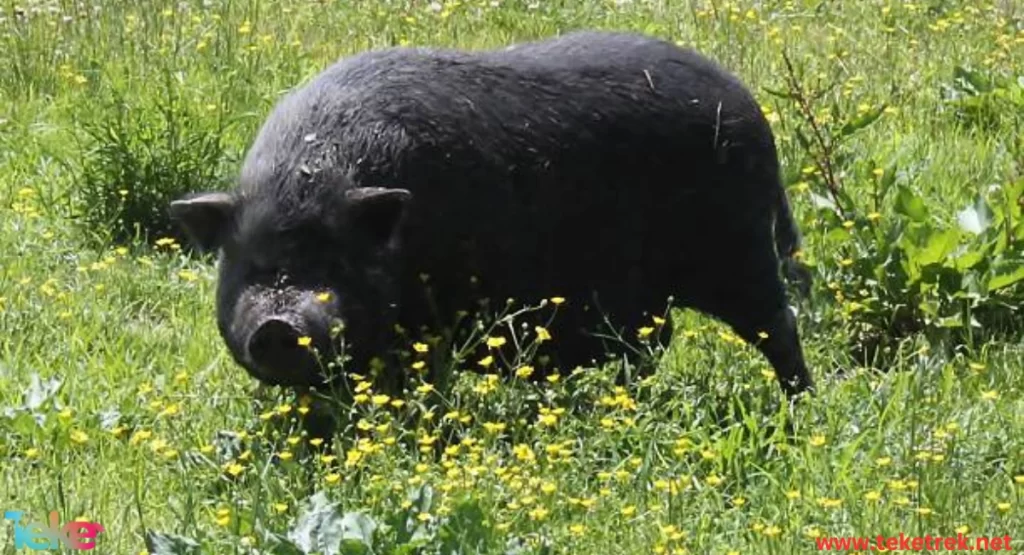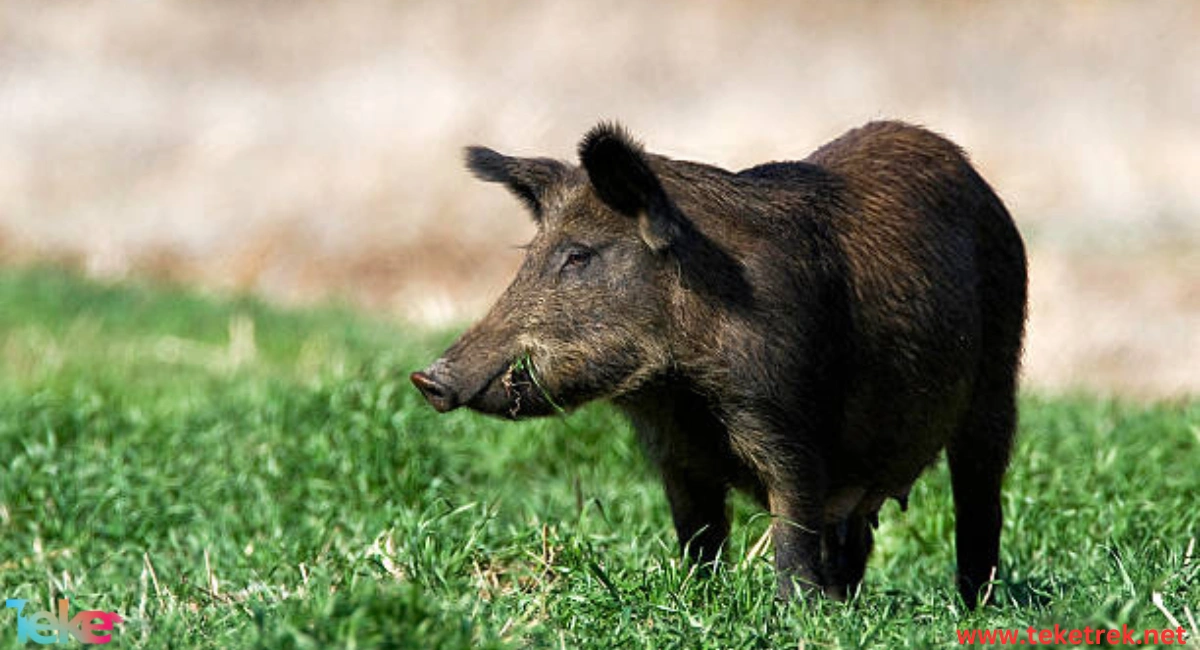Wild pigs are among the fiercest types of pigs. They live in habitats and dense forests. You can also find them in scattered mountainous areas and in forests near swamps. They prefer to live in humid areas and agricultural lands. They prefer to eat dead animals and mollusks. Their physical build helps them adapt to semi-desert areas, so they adapt to all climates and live in all environments, but they do not like extreme cold or extreme heat. Their long nostrils also help them extract mollusks from the soil, so humid habitats and swamps are among their favorite places.
They prefer to sleep and rest in areas covered with grass and leaves. This type of pig reproduces abundantly and is known for destroying agricultural crops. Therefore, their presence in agricultural areas poses a great danger, which is why farmers are keen to displace them from agricultural lands. Here is everything you need In this article from teketrek، to know about Feral Pigs.
Wild pigs’ food
Wild pigs, like any other pig, feed on what they find around them in the environment in which they live. Wild pigs feed on acorns, tuberous plants, and oak fruits. Their body structure and long trunk shape help them dig for food hidden in the soil, where they search for mollusks, amphibians, and arthropods. They also feed on dead animals and carrion, and because of the vileness of what they eat, they pose a serious threat to the soil and agricultural environment.
Wild pigs, if they do not have their favorite meals, resort to eating flowers, fruits, tree leaves, tree bark, and plant roots. They use their hard noses to dig and search for food and roots inside the ground, and they hunt rabbits and rats. This means that wild pigs eat everything they find in front of them, whether grass, insects, or dead animals.

Wild pig habitat
The wild pig lives in humid areas, where it prefers these areas very much because they are home to many mollusks and worms that it loves to eat. It also lives in agricultural lands close to agricultural crops, as it prefers to eat grass, fruits and crops if it does not find its favorite food. This type of pig is also widespread in semi-desert areas, and despite that, it hates extreme heat and avoids very cold places.
Many groups of it are spread in many Arab and non-Arab countries, such as Algeria, Iraq, Syria, Palestine, Armenia, Turkey, Iran, Austria, Bulgaria, China, India, Indonesia, France, Japan, the Netherlands, Pakistan, Australia, North and South Korea, Czech Republic, Georgia, Bosnia and Herzegovina, Malaysia, Nepal, Poland, and other countries. Farmers are keen to displace them from agricultural areas because they harm the soil. This type has become extinct in Egypt, Libya, Ireland, and Norway.
https://teketrek.net/angler-fish-the-dark-predator-of-the-deep-sea/
Reproduction in wild pigs
Wild pigs reproduce abundantly, as the number of fetuses in one pregnancy may reach about seven fetuses, and the number may increase to ten fetuses. They are also animals that mature quickly, as the female reaches maturity seven months after birth, while the male reaches maturity after birth about 11 months. They do not have a specific date or season for birth, as they reproduce throughout the year. It is worth noting that their gestation days are few, as they carry and give birth within 115 to 125 days.
Wild pigs live for many years, as their average lifespan is about 15 years if they are in the wild, while their lifespan in captivity is about 20 years. The weight of females is about 100 to 130 kg, while the weight of males ranges from 29 to 80 kg, and their length ranges from 100 to 170 cm.
Feral pigs environmental impact
Wild pigs are very voracious animals and eat everything they find in front of them. They are also very active at night and take the day as a resting place. Their behavior greatly affects the environment and agricultural lands, which also poses a danger to human life. If their numbers increase significantly, they cause devastation, as happened in Italy, where they caused losses to the agricultural sector estimated at about 120 million euros.
Pigs attack agricultural crops such as olive trees, corn fields, and vineyards. They also dig the soil and eat seeds, so they pose a serious threat to crops and farmers are keen to get rid of them immediately. They also destroy many facilities such as eating grass and destroying the land in gardens, children’s play areas, football fields, and sports areas.
https://teketrek.net/georgia-aquarium-the-largest-aquarium-in-the-world-what-does-it-offer-visitors/
Interesting facts about wild pigs
The wild pig is a strange creature and its behavior and way of eating are not like other animals, so there are many facts that may surprise you when you know about it and can be mentioned as follows:
Did you know that the wild pig is not able to swallow rough fibrous food but sucks the juice inside it and then spits it out.
Did you know that a female pig can give birth five times a year.
Did you know that a pig can feed on the feces that come out of it.
Did you know that the wild pig hates the smell of human hair and mothballs.
It has a strong sense of hearing that is much better than humans.
Did you know that the pig is the only animal that extracts seeds from the soil and eats them.

FAQs about wild pigs
Are wild pigs dangerous Australia?
Yes, as their large numbers have increased, causing them to attack agricultural crops in search of food, which has led to huge losses for the agricultural sector, and a decision has been issued to kill them.
How did wild pigs reach Australia?
Pigs migrate from one country to another and if they find a country where they feel safe and can hide, they make it their home and reproduce there, and this is what happened in Australia.
How many feral pigs in Australia
The number of wild pigs in Australia has reached about 3 million pigs.
Why are feral pigs a problem in the US?
Because with their large increase in numbers, they have become fearless From humans, but they attack many people and have become very fierce, in addition to their attack on agricultural crops and facilities, where they caused losses estimated at about 270 million US dollars.
Why are feral pigs a problem in Australia?
Because their large reproduction has led to their numbers doubling, which made them invade agricultural areas and crops and destroy them and extract planted seeds.
In conclusion, wild pigs are animals that attract a lot of interest due to their strength and flexibility in adapting to diverse environments. Although they may pose a threat to agriculture and the ecosystem in some areas, they have an ecological role in maintaining the natural balance through their interaction with the surrounding environment. Preserving biodiversity requires a better understanding of these animals, regular monitoring of their numbers, and effective management to reduce the damage they may sometimes cause. Dealing with wild pigs remains a challenge that requires coordination between scientists, farmers, and stakeholders to achieve a balance between protecting the environment and regulating human life.





